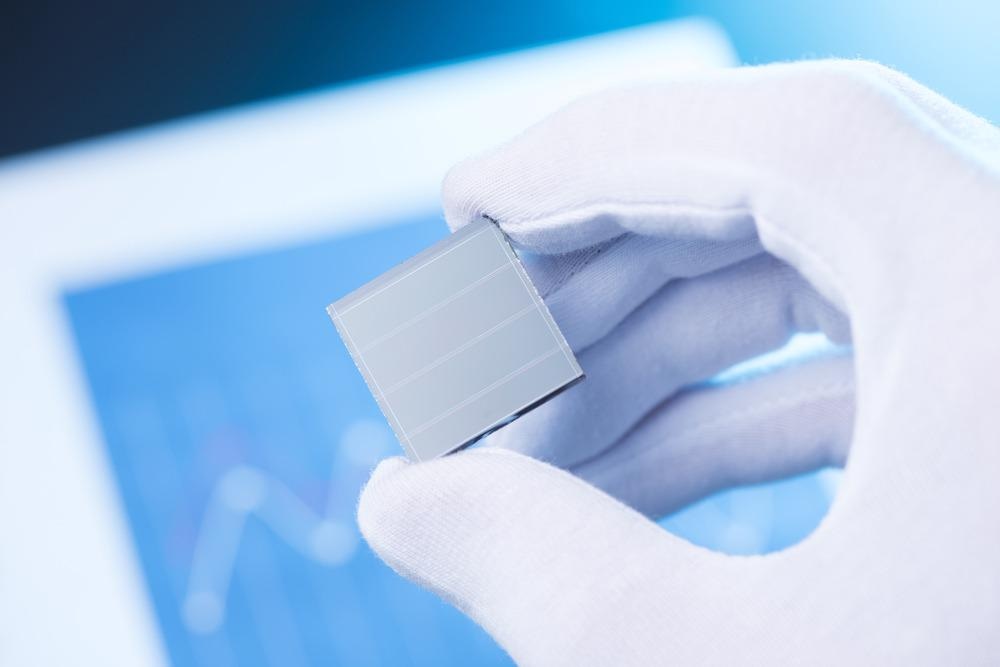Perovskite solar cells and quantum dots (QDs) play an important role in enhancing the efficiency of solar cells. In an article recently published in Scientific Reports, the researchers synthesized titanium oxide-coated zinc oxide (TiO2@ZnO) nanocomposites and applied them to fabricate solar cells and investigated their efficiency.

Study: Synthesis and evaluation of composite TiO2@ZnO quantum dots on hybrid nanostructure perovskite solar cell. Image Credit: nevodka/Shutterstock.com
Increasing the Efficiency in Solar Cells
Solar cells have gained prominence with an increasing demand for renewable energy sources. Compared to silicon solar cells, organometallic perovskite solar cells served as a better alternative energy source due to their ease of synthesis, cost-effective fabrication, and inexpensive components. Nanomaterials like QDs have gained considerable attention in the recent past due to their optical characteristics. Moreover, the tunable bandgaps in QDs are favorable for their application in solar cells.
QDs are the semiconducting crystals of nanoscale range between 1 to 10 nanometers. Semiconducting materials have electrical conductivity between conducting and non-conducting materials.
Since the perovskite solar cells are composed of several layers consisting of compact and mesoporous titanium oxide (TiO2) perovskite light-absorbing layer, an electrode (Au) and a hole-transport layer, the studies on perovskite solar cells can be performed on any part of the cell. Moreover, incorporating nanomaterials in a few of these layers may increase the overall efficiency of solar cells.
TiO2@ZnO QDs
In the present study, the researchers synthesized the TiO2@ZnO composite and studied its electron-donating properties in the perovskite solar cell using QDs of TiO2 and ZnO.
They produced a clean source of energy by applying the advantages of nanotechnology in preparing efficient solar cells. The synthesized TiO2@ZnO nanocomposite was explored for its applications and efficiency by varying the ratios of TiO2 and ZnO QDs. Despite the reported efficiency of the fabricated TiO2@ZnO solar cell being 5%, this efficiency could be further increased by optimizing fabrication conditions like the optimal location for the cells or by combining it with other materials.
Research Findings
Fourier-transform infrared spectroscopy (FT-IR) results of ZnO showed peaks at 447-centimeter inverse corresponding to Zn-O vibration, 705-centimeter inverse corresponding to Zn-hydroxyl (OH), 1352-centimeter inverse corresponding to carbonyl (C=O) bond in zinc acetate, 1487-centimeter inverse related to alkene (C=C) bond of zinc acetate, 1577-centimeter inverse corresponding to alkyl (C-H) stretching vibration in zinc acetate, and 3294-centimeter inverse corresponding to the O-H bond.
In the infrared (IR) spectrum of TiO2 QDs, the broad peak at 3000-3400-centimeter inverse corresponds to O-H stretching vibration, representing the presence of water molecules. The peak at 1627-centimeter inverse was related to the stretching vibration of C=O in titanium carboxylate, formed due to a reaction between titanium isopropoxide and ethanol present along with TiO2 QDs. The peaks observed at 1047 belonged to the Ti-oxygen (O)-carbon (C) group and those at 474 and 800-centimeter inverse to Ti–O in TiO2.
Field emission scanning electron microscope (FE-SEM) images showed that TiO2 QDs had spherical morphology with particle sizes between 6 and 8 nanometers. The particles showed agglomeration of QDs. The ZnO QDs also showed spherical morphology with particle sizes between 5 and 9 nanometers.
Transmission electron microscopy (TEM) images showed that the average particle size of TiO2 QDs was about 7 nanometers, indicating the existence of TiO2 QDs in different sizes. The TEM images also revealed that the average particle size of ZnO QDs was about 6 nanometers.
The X-ray diffraction (XRD) spectrum revealed 2θ peaks at 25.3, 38.0, 48.1, 54.2, 55.1, 62.8, 68.9, 70.4 and 75.3 for the crystal planes of TiO2 anatase (101), (004), (200), (105), (211), (204), (116), (220) and (107) indices. Moreover, the diffraction peaks in ZnO XRD patterns showed 2θ peaks at 31.68, 34.35, 36.09, 47.36, 56.48, 62.70, 66.23, 67.87, 68.99 and 76.77 with crystallographic pages (100), (002), (101), (102), (110), (103), (112) and (201).
The current-voltage analysis helped determine cell efficiency, cell filling factor, and open-circuit voltage short circuit current. Fabrication of three perovskite solar cells yielded the best results in the 2:1 ratio of TiO2: ZnO, which was 5.21%, for the 1:1 ratio of TiO2: ZnO was 2.3% and for 2:1 ZnO@TiO2, it was 3.7%.
Conclusion
In conclusion, the researchers synthesized the TiO2@ZnO composite and studied the applications of these composites with varying ratios of TiO2 and ZnO QDs. They reported 5% efficiency in solar cells made of TiO2@ZnO composite in a 2:1 ratio, indicating that the presence of TiO2 is more favorable than ZnO to increase efficiency and electron movement.
The overall efficiency of this solar cell could be increased by either combining it with other materials or optimizing the conditions. Additional ways of increasing efficiency included using core-shell composites with TiO2@ZnO composites and tandem solar cells with TiO2@ZnO composites.
Reference
Negin Pezhooli, Jamal Rahimi, Farzam Hasti and Ali Maleki. (2022). Synthesis and evaluation of composite TiO2@ZnO quantum dots on hybrid nanostructure perovskite solar cell. Scientific Reports. https://doi.org/10.1038/s41598-022-13903-w
Disclaimer: The views expressed here are those of the author expressed in their private capacity and do not necessarily represent the views of AZoM.com Limited T/A AZoNetwork the owner and operator of this website. This disclaimer forms part of the Terms and conditions of use of this website.